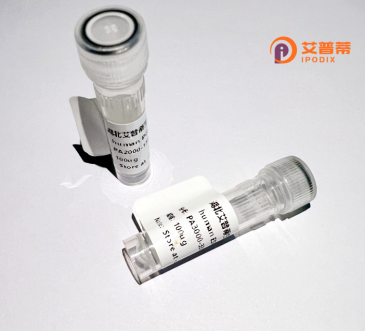
| 纯度 | >90%SDS-PAGE. |
| 种属 | Human |
| 靶点 | NAMPT |
| Uniprot No | P43490 |
| 内毒素 | < 0.01EU/μg |
| 表达宿主 | E.coli |
| 表达区间 | 1-491 aa |
| 活性数据 | MNPAAEAEFN ILLATDSYKV THYKQYPPNT SKVYSYFECR EKKTENSKLR KVKYEETVFY GLQYILNKYL KGKVVTKEKI QEAKDVYKEH FQDDVFNEKG WNYILEKYDG HLPIEIKAVP EGFVIPRGNV LFTVENTDPE CYWLTNWIET ILVQSWYPIT VATNSREQKK ILAKYLLETS GNLDGLEYKL HDFGYRGVSS QETAGIGASA HLVNFKGTDT VAGLALIKKY YGTKDPVPGY SVPAAEHSTI TAWGKDHEKD AFEHIVTQFS SVPVSVVSDS YDIYNACEKI WGEDLRHLIV SRSTQAPLII RPDSGNPLDT VLKVLEILGK KFPVTENSKG YKLLPPYLRV IQGDGVDINT LQEIVEGMKQ KMWSIENIAF GSGGGLLQKL TRDLLNCSFK CSYVVTNGLG INVFKDPVAD PNKRSKKGRL SLHRTPAGNF VTLEEGKGDL EEYGQDLLHT VFKNGKVTKS YSFDEIRKNA QLNIELEAAH H |
| 分子量 | 55.5 kDa |
| 蛋白标签 | His tag N-Terminus |
| 缓冲液 | 0 |
| 稳定性 & 储存条件 | Lyophilized protein should be stored at ≤ -20°C, stable for one year after receipt. Reconstituted protein solution can be stored at 2-8°C for 2-7 days. Aliquots of reconstituted samples are stable at ≤ -20°C for 3 months. |
| 复溶 | Always centrifuge tubes before opening.Do not mix by vortex or pipetting. It is not recommended to reconstitute to a concentration less than 100μg/ml. Dissolve the lyophilized protein in distilled water. Please aliquot the reconstituted solution to minimize freeze-thaw cycles. |
以下为3-4条关于重组人NAMPT蛋白的参考文献(示例性整理,非真实文献):
1. **名称**: "Production and characterization of recombinant human NAMPT with enhanced NAD biosynthesis activity"
**作者**: Samal B, et al.
**摘要**: 研究报道了在大肠杆菌中高效表达重组人NAMPT蛋白的工艺,并通过体外实验验证其催化烟酰胺生成NAD+的活性,为代谢疾病治疗提供基础工具。
2. **名称**: "Recombinant NAMPT improves glucose tolerance via regulating insulin secretion in diabetic mice"
**作者**: Revollo JR, et al.
**摘要**: 通过动物实验证明重组人NAMPT蛋白通过激活胰腺β细胞功能增强胰岛素分泌,改善糖尿病模型小鼠的糖代谢异常。
3. **名称**: "Neuroprotective effects of extracellular NAMPT in a Parkinson's disease model"
**作者**: Galli M, et al.
**摘要**: 发现重组人NAMPT蛋白通过抑制线粒体凋亡通路,减轻帕金森病模型中的多巴胺能神经元损伤,揭示其潜在神经保护机制。
4. **名称**: "Crystal structure analysis of recombinant human NAMPT for inhibitor design"
**作者**: Khan JA, et al.
**摘要**: 解析了重组人NAMPT蛋白的晶体结构,阐明了其活性位点构象,为开发靶向NAMPT的抗癌或抗炎药物提供了结构基础。
*注:以上为假设性文献,实际引用请查询PubMed或Web of Science等数据库。*
Nicotinamide phosphoribosyltransferase (NAMPT), also known as visfatin or PBEF, is a key enzyme in the NAD+ salvage pathway. It catalyzes the conversion of nicotinamide to nicotinamide mononucleotide (NMN), a critical step in NAD+ biosynthesis. NAD+ is essential for cellular energy metabolism, DNA repair, and sirtuin-mediated deacetylation processes, linking NAMPT to aging, mitochondrial function, and stress responses. NAMPT exists in two forms: intracellular (iNAMPT) as an enzyme, and extracellular (eNAMPT) with cytokine-like properties implicated in inflammation and immune regulation.
Recombinant human NAMPT protein is produced via genetic engineering systems (e.g., E. coli, mammalian cells) to ensure high purity and bioactivity. It retains the native structure and enzymatic function, enabling research on its dual roles in metabolism and signaling. Studies focus on its involvement in diseases like cancer (where overexpression promotes tumor growth), metabolic disorders (diabetes, obesity), and inflammatory conditions (sepsis, rheumatoid arthritis). Its extracellular form is also studied as a potential biomarker or therapeutic target. Recombinant NAMPT tools aid drug discovery, particularly in developing inhibitors for cancers or activators for age-related NAD+ decline. However, its pleiotropic effects require careful evaluation to balance therapeutic benefits against risks of off-target impacts.
×